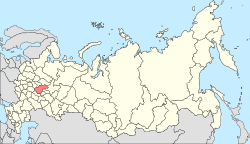Arzamas
| Arzamas (English) Арзамас (Russian) |
|
|---|---|
| - City - | |
 11th microdistrict of Arzamas |
|
 Location of Nizhny Novgorod Oblast in Russia |
|
|
|
|
|
|
|
|
|
|
| Administrative status (as of March 2012) | |
| Country | Russia |
| Federal subject | Nizhny Novgorod Oblast |
| Administratively subordinated to | city of oblast significance of Arzamas |
| Administrative center of | Arzamassky District, city of oblast significance of Arzamas |
| Municipal status (as of August 2009) | |
| Urban okrug | Arzamas Urban Okrug |
| Administrative center of | Arzamas Urban Okrug, Arzamassky Municipal District |
| Mayor | Mikhail Buzin |
| Representative body | City Duma |
| Statistics | |
| Area (2010) | 34.32 km2 (13.25 sq mi) |
| Population (2010 Census) | 106,362 inhabitants |
| - Rank in 2010 | 152nd |
| Density | 3,099/km2 (8,030/sq mi) |
| Time zone | MSK (UTC+03:00) |
| Founded | 1578 |
| City status since | 1781 |
| Postal code(s) | 607220-607233 |
| Dialing code(s) | +7 83147 |
|
|
|
| on | |
Arzamas (Russian: Арзама́с) is a city in Nizhny Novgorod Oblast, Russia, located on the Tyosha River (a tributary of the Oka), 410 kilometers (250 mi) east of Moscow. Population: 106,362 (2010 Census);109,432 (2002 Census);108,951 (1989 Census).
Arzamas was founded in 1578 by Ivan the Terrible in the lands populated at the time by Mordvins. By 1737, more than 7,000 people lived in Arzamas and the town became a major transit center on the route from Moscow to eastern parts of Russia. It was known for its geese and onions as well as leather crafts.
Catherine the Great in 1781 granted town status to Arzamas and a coat of arms based on the colors of the Arzamas regiment. In the early 19th century, Arzamas had over twenty churches and cathedrals, the foremost being the Resurrection Cathedral. It was built in the Empire style to commemorate the Russian victory over Napoleon in 1812.
Alexander Stupin art school was located in Arzamas between 1802 and 1862 and many famous Russian artists studied there, including Vasily Perov.
In 1954-1957, Arzamas was the center of Arzamas Oblast, a short-lived administrative unit that was split from Gorky Oblast and later merged back into it.
...
Wikipedia



